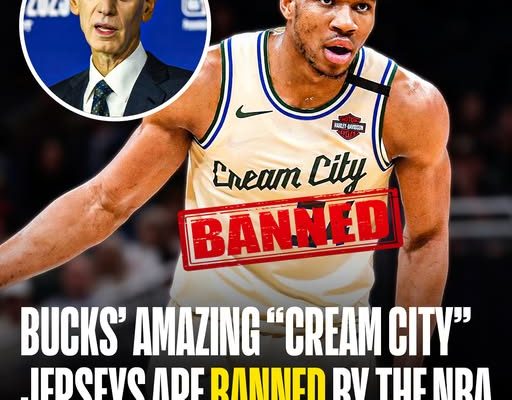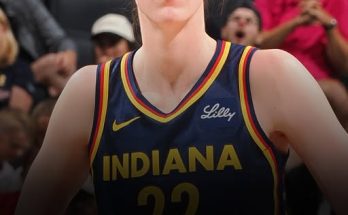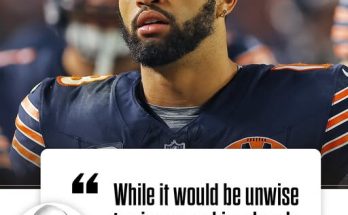The NBA is no stranger to controversies, whether they involve player trades, officiating disputes, or even something as seemingly trivial as a uniform design. Yet, in a season already filled with unexpected drama both on and off the court, few stories have generated as much head-scratching debate as the league’s recent decision to shut down the Milwaukee Bucks’ iconic jersey due to what many are calling a bizarre and unnecessary controversy. While jerseys often represent pride, tradition, and fan connection, this incident has raised questions about the NBA’s priorities, its relationship with its teams, and the fine line between commercial interests, fan sentiment, and the league’s overarching image. For a franchise like the Bucks, whose history is intertwined with unique jersey designs and a passionate Midwest fanbase, the sudden removal of an iconic uniform feels like a move that undermines not just tradition but also the ongoing narrative of identity that sports teams rely on to foster loyalty and community.
The controversy began quietly at first, with murmurs of dissatisfaction coming from sources close to the league office. What initially appeared to be minor criticism regarding the Bucks’ alternate “iconic throwback” jersey slowly evolved into a full-blown dispute that eventually made its way into national sports headlines. The jersey in question, a bold blend of the franchise’s historic green and cream colors with modern accents, had been a fan favorite since its release. Many supporters of the Bucks considered it a tribute to the team’s championship heritage, especially following the 2021 title run led by Giannis Antetokounmpo. However, according to reports, certain elements of the design—ranging from its unconventional font styling to an alleged trademark conflict—caught the attention of league executives and sponsors, sparking internal debates about whether the uniform adhered to the NBA’s official standards.
As the story unfolded, it became clear that this was not just a case of aesthetic preferences. Sources suggested that the controversy might be linked to sponsorship deals and licensing agreements that dictate how NBA jerseys are produced, marketed, and displayed. In today’s sports economy, where jersey sales represent a massive revenue stream for both teams and the league, the design of a uniform is not merely a creative expression of a franchise’s identity. It is also a commercial product subject to stringent rules around branding, manufacturer rights, and intellectual property. In the Bucks’ case, reports indicated that a minor yet significant dispute over a design pattern on the side panels of the jersey snowballed into a larger battle between the franchise’s apparel partners and the league’s central marketing team. Some insiders have speculated that the unique deer-themed motif on the jersey conflicted with a visual branding campaign the league had planned for other teams, creating friction over merchandising priorities.
What made this situation even stranger is how the NBA handled the rollout of information. Initially, there was no official statement from the league. Instead, whispers and leaks began circulating among sports journalists and fan blogs, suggesting that the Bucks had been quietly instructed to pull the jersey from future games. Fans attending home games started noticing that the team stopped wearing the alternate jersey without explanation, leading to speculation on social media. Was it an issue with player feedback? Did the uniform violate some obscure technical rule? Or was it something more controversial, like political messaging embedded in the design? Conspiracy theories ran wild, fueled by the league’s silence and the team’s reluctance to clarify matters.
Eventually, the NBA did release a carefully worded statement, acknowledging that the jersey was being “suspended from active use pending a review of compliance with league guidelines.” While this announcement provided some clarity, it did little to quell the frustration of Bucks fans who felt blindsided by the decision. The phrase “pending a review” suggested that the jersey could potentially return in the future, but the lack of a concrete timeline or explanation left many feeling that the league was being unnecessarily opaque. The timing of the decision also raised eyebrows, as it came during a season in which the Bucks were enjoying strong performances on the court. With Giannis Antetokounmpo, Damian Lillard, and Khris Middleton forming one of the league’s most formidable trios, the sudden removal of a beloved jersey felt like an unwelcome distraction for both the players and their supporters.
From a historical standpoint, the Bucks have always had a unique relationship with their uniforms. Unlike some franchises that stick to a rigid color palette or traditional designs, Milwaukee has often embraced creativity, incorporating elements of its cultural and regional identity into its jerseys. The infamous “Irish Rainbow” jersey of the 1980s, for example, remains a nostalgic favorite among older fans, while the more recent “Cream City” uniforms drew widespread praise for celebrating the team’s hometown heritage. The controversial jersey in question was viewed by many as the perfect fusion of past and present, combining retro influences with modern flair. It symbolized not just the team’s success but also its willingness to innovate. Therefore, seeing the league intervene to remove such a design felt like a slap in the face to the Bucks organization and its fans, who had invested emotionally and financially in the jersey’s popularity.
Financial considerations undoubtedly played a role in this saga. The NBA’s partnership with Nike, which manufactures all official team apparel, means that jersey designs are subject to approval not just from the league but also from corporate partners. Some analysts believe that the Bucks’ jersey may have inadvertently violated a clause related to exclusive design rights or clashed with a broader apparel strategy planned for the upcoming playoffs. In a market as competitive as sports apparel, where every jersey release is accompanied by marketing campaigns, pop-up shops, and social media blitzes, even a small deviation from agreed-upon design templates can create headaches for all parties involved. The fact that this dispute escalated to the point of removing a jersey altogether suggests that the issue was not simply about aesthetics, but rather about control and the balancing of corporate interests with team autonomy.
The players, for their part, have remained relatively quiet on the issue, but subtle signs of frustration have emerged. Giannis Antetokounmpo, known for his charismatic and straightforward personality, was asked about the controversy during a postgame press conference. While he stopped short of criticizing the league, his tone suggested disappointment. “That jersey means something to us,” Giannis said. “It’s part of who we are, and it connects us with the fans. I hope things get resolved because we love wearing it.” Damian Lillard, who joined the Bucks this season in a blockbuster trade, echoed similar sentiments, noting that players often develop a special connection to certain uniforms because of the memories they create while wearing them. The silence from other team officials, however, indicates that the franchise may be under strict instructions from the league not to comment further while the matter is being investigated.
Meanwhile, fans have taken matters into their own hands. Social media campaigns such as #BringBackTheBucksJersey and petitions addressed to the NBA commissioner have gained traction, with thousands of signatures urging the league to reverse its decision. Many fans have pointed out that the NBA’s move appears inconsistent, especially when other teams have been allowed to experiment with bold and unconventional jersey designs. For instance, the Miami Heat’s “Vice” jerseys, which featured neon colors and retro fonts, received nothing but praise from the league. So why is Milwaukee’s iconic jersey being singled out? Some believe that the Bucks’ smaller market status makes them an easier target for such decisions, while others suspect that the league may be attempting to assert greater control over all jersey designs moving forward.
The sports merchandising world has also taken a hit as a result of this controversy. Retailers who stocked up on the now-discontinued Bucks jersey have found themselves in a strange position. On one hand, the scarcity of the jersey has turned it into a collector’s item, with resale prices skyrocketing on platforms like eBay. On the other hand, the sudden removal of the product has disrupted sales and marketing plans, leaving many retailers scrambling to adjust. Some have even accused the NBA of mishandling the rollout and failing to communicate with partners in the retail sector, further straining relationships between the league and its commercial collaborators.
The incident also raises larger questions about the role of sports leagues in dictating team identity. While it is understandable that the NBA, as a global brand, wants to maintain certain standards of visual consistency and protect its commercial interests, there is an ongoing debate about whether this level of control comes at the expense of team individuality and local culture. Jerseys are more than just clothing; they are symbols that encapsulate the history, values, and aspirations of a franchise. For the Bucks, whose journey from underdog status to NBA champions has been a story of resilience and community pride, the removal of an iconic jersey feels like an erasure of that narrative. Fans are left wondering whether the league truly understands the emotional weight that such decisions carry.
In the broader context of professional sports, this controversy is not entirely unprecedented. Other leagues have faced similar disputes over uniforms, often involving clashes between creative expression and corporate guidelines. For example, in the NFL, teams have occasionally been forced to abandon alternate uniforms due to conflicts with league rules or sponsorship arrangements. However, the NBA has traditionally been seen as more progressive and open to innovation, which makes this particular incident all the more surprising. The league’s embrace of “City Edition” jerseys, which allow teams to experiment with designs inspired by their local culture, has been widely celebrated in recent years. So why, fans ask, would the NBA backtrack on that spirit of creativity by targeting the Bucks’ jersey?
One theory suggests that the controversy may have been amplified by internal disagreements within the league’s marketing and operations departments. As the NBA continues to expand its global reach, particularly in lucrative markets like China and Europe, the importance of maintaining a consistent brand image has grown. Some executives may have viewed the Bucks’ jersey as deviating too far from that image, especially if it included design elements that might not resonate with international audiences. Others, however, argue that such uniqueness is precisely what makes the NBA appealing on a global stage. After all, fans in other countries are often drawn to the league because of its diversity, both in terms of players and team identities.
The Milwaukee Bucks organization now finds itself at a crossroads. While the team has reportedly complied with the league’s directive to remove the jersey, there are indications that they are exploring legal and contractual options to reinstate it. This could lead to a protracted battle behind closed doors, as both sides weigh the financial and reputational risks of pursuing the matter further. For the Bucks’ front office, the controversy comes at an especially delicate time. With championship aspirations and a roster built around one of the most dominant players in NBA history, the last thing the franchise needs is an off-court distraction that divides its fanbase and disrupts its branding efforts.
In many ways, this controversy has become a symbol of the tension between tradition and commercialization in modern sports. Fans crave authenticity and connection to their team’s history, while leagues and corporate sponsors prioritize revenue streams and global marketability. Finding a balance between these competing interests is not easy, but the Bucks jersey saga illustrates what happens when that balance tips too far in one direction. As more fans voice their displeasure and media outlets continue to cover the story, pressure is mounting on the NBA to find a resolution that satisfies both the league’s business partners and the passionate supporters who make the sport what it is.
Even beyond the Bucks fanbase, other NBA teams are watching this situation closely. If the league can unilaterally shut down a popular jersey due to vague “compliance” issues, what does that mean for the future of team branding? Will franchises have less say in how they express their identity? Could we see a shift toward more homogenized, league-approved designs that prioritize commercial appeal over local authenticity? These are questions that resonate far beyond Milwaukee, touching on the very heart of what makes sports so compelling to fans. The unique colors, logos, and designs that teams adopt are not just marketing tools; they are part of the storytelling fabric that connects players and supporters across generations.
As of now, the future of the iconic Bucks jersey remains uncertain. Some reports suggest that negotiations are ongoing between the team, Nike, and the NBA to modify certain aspects of the design in order to bring it back in a revised form. Others fear that the jersey may be gone for good, relegated to the status of a collector’s item and a cautionary tale about the pitfalls of modern sports branding. Regardless of the outcome, one thing is clear: this controversy has struck a chord with fans and highlighted the complex interplay between tradition, commerce, and identity in professional basketball.
For those who have followed the NBA closely over the past decade, this situation is particularly ironic. The league has often prided itself on being more in tune with fan culture compared to other professional sports organizations. Initiatives like the City Edition jerseys, the embrace of player individuality, and the use of social media to connect with younger audiences have all contributed to the NBA’s reputation as a progressive and fan-friendly league. Yet, the decision to shut down the Bucks’ jersey stands in stark contrast to that image, making many wonder whether the league is starting to lose touch with the very audience it has worked so hard to cultivate.
The media response to this controversy has also been telling. While some outlets have treated it as a minor story compared to trade rumors or playoff projections, others have delved deeply into the implications of the decision. Sportswriters and analysts have debated whether this is a sign of the league becoming overly corporate and risk-averse, prioritizing sponsorship dollars over fan engagement. Some have even drawn parallels to past controversies involving player expression, such as when the NBA imposed dress code rules in the mid-2000s or cracked down on certain social justice messages during games. In each case, the league faced backlash for what critics saw as attempts to control narratives and stifle individuality.
The Bucks themselves have tried to maintain a professional and diplomatic stance, but the frustration is palpable among the fan community. For many, the jersey represented more than just a piece of apparel; it was a tangible link to a golden era of Bucks basketball, a period marked by resilience, triumph, and community pride. To see it suddenly banned by the league feels like an erasure of that history. Some fans have even staged small protests outside the Fiserv Forum, wearing the controversial jersey in defiance and holding signs that read “Our Team, Our Jersey.” The emotional response underscores how deeply sports identities are woven into the fabric of local communities, and how decisions made in corporate boardrooms can ripple through fan culture in unexpected ways.
There is also an economic angle to consider. Milwaukee, as one of the smaller NBA markets, relies heavily on local fan engagement and merchandise sales to compete financially with larger franchises in cities like Los Angeles, New York, or Miami. The removal of a best-selling jersey not only affects the team’s bottom line but also weakens its ability to leverage its brand in a competitive market. Local businesses that sold Bucks merchandise have expressed disappointment, noting that the jersey was one of their top-selling items during the season. For a community that prides itself on supporting its team through thick and thin, the league’s decision feels like an unnecessary blow to both morale and local commerce.
It is worth noting that this controversy comes at a time when the NBA is already grappling with other challenges. Television ratings, while still strong, have fluctuated in recent years as younger audiences shift toward streaming and social media highlights. International markets, particularly China, have presented both opportunities and political challenges for the league. In this context, alienating a dedicated fanbase over a jersey design seems counterproductive. Some analysts have even suggested that the NBA’s move could set a dangerous precedent, leading to increased micromanagement of team branding decisions in the future.
In the end, the Bucks jersey saga may be remembered as more than just a quirky chapter in NBA history. It has become a flashpoint for larger conversations about who controls the narrative of sports and how much say fans and local communities have in shaping their team’s identity. As the league continues to grow and evolve, striking the right balance between commercial interests and authentic representation will be crucial. For now, Bucks fans remain hopeful that their voices will be heard and that the iconic jersey will make a triumphant return to the court.



